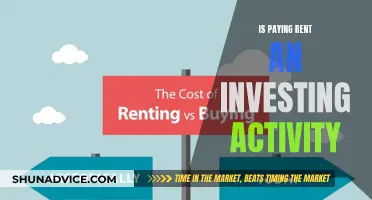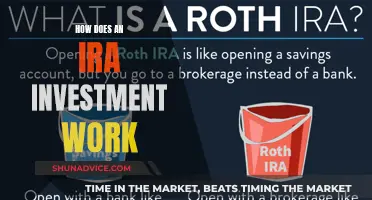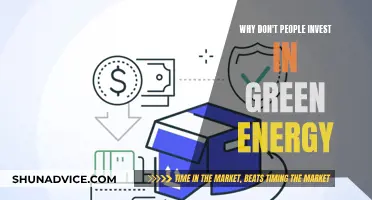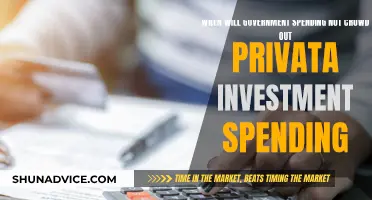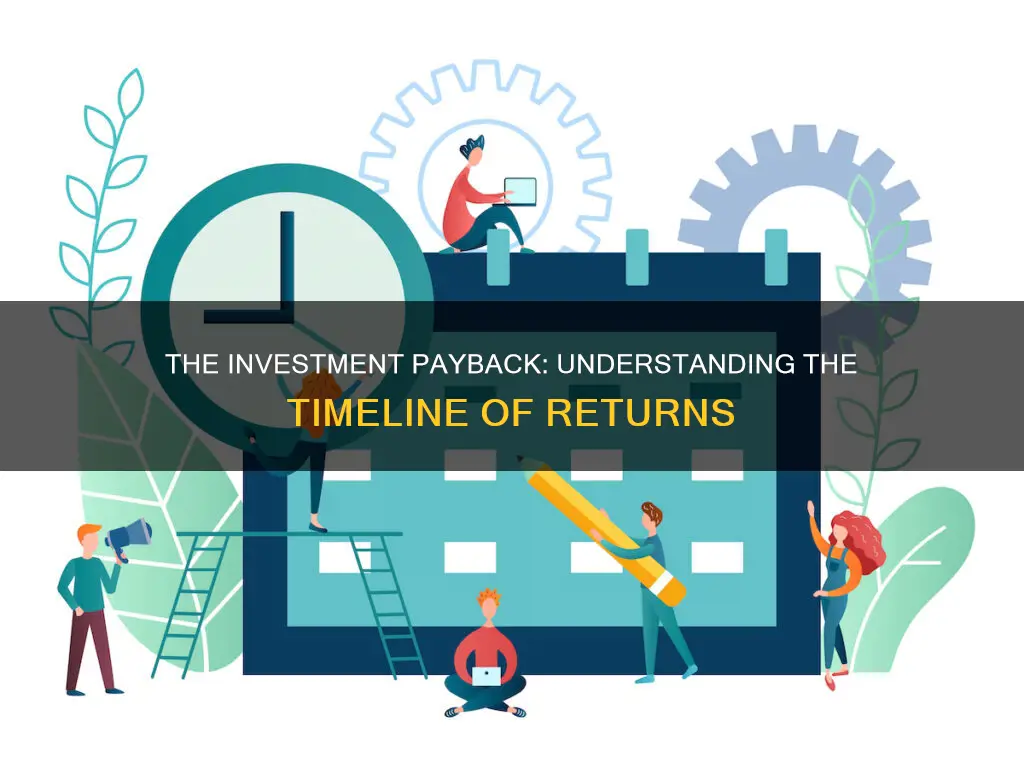
The “payback period” is a key term for anyone in a position to start investing. It refers to the amount of time it takes for an investment to pay for itself and make a profit. This is separate from a loan repayment schedule. For example, solar panels can save you money on electricity bills, but they require an upfront investment that will take time to pay off. The payback period for solar panels is usually 7 to 10 years, after which you will profit from the savings on your electricity bills. Similarly, investing in stocks, bonds, or property can generate returns over time, but it's important to carefully consider the risks and potential gains before committing.
| Characteristics | Values |
|---|---|
| Definition | The payback period is the amount of time it takes to recover the cost of an investment. |
| Calculation | Cost of Investment ÷ Average Annual Cashflow = Payback Period |
| Example | $15,000 (upfront investment) ÷ $1,500 (annual savings) = 10-year payback period |
| Considerations | The shorter the payback period, the better. However, it depends on the kind of investment, the level of risk, and how long you're willing to wait. |
| Compounding | The more time your money has, the more money you can earn. Compounding is the process of reinvesting an asset's earnings to generate additional earnings over time. |
| Recommended Allocation | According to the 50/15/5 rule, 15% of pretax income should be invested for retirement. |
What You'll Learn
- The payback period is the amount of time it takes to recover the cost of an investment
- The shorter the payback period, the better
- The power of compounding: reinvesting returns to generate more returns over time
- The longer you can let your money grow, the better
- The more money you can put into your investments, the better

The payback period is the amount of time it takes to recover the cost of an investment
The payback period is a crucial metric in investment decision-making, and it refers to the amount of time it takes to recover the cost of an investment. In other words, it answers the question, "How long until this investment pays for itself?"
The payback period is calculated by dividing the initial investment by the average annual cash flow. For example, if you invest $15,000 in solar panels to save $1,500 each year on your energy bill, the payback period would be:
$15,000 (initial investment) ÷ $1,500 (annual savings) = 10 years.
So, it would take 10 years to break even on this investment. After that, you would start pocketing the full amount of the annual savings.
The payback period is a popular metric because of its simplicity, and it is often used as an initial analysis or additional reference when evaluating potential investments. It is a straightforward way to assess the risk of an investment, as shorter payback periods are generally more attractive and less risky.
However, one drawback of the payback period is that it disregards the time value of money. This concept acknowledges that money today is worth more than the same amount in the future due to its earning potential. Other methods, such as net present value (NPV) and internal rate of return (IRR), take this into account and may be used alongside the payback period for a more comprehensive evaluation.
When considering an investment, it is essential to weigh all factors, including the payback period, potential profitability, and your risk tolerance, to determine if it aligns with your goals and expectations.
Green Energy: Why the Hesitation?
You may want to see also

The shorter the payback period, the better
When considering an investment, it is always a good idea to calculate the payback period—the amount of time it will take to recover the cost of the investment and start turning a profit. The shorter the payback period, the better, as this means that the investment's risk level is only relevant for a shorter period.
For example, if you spend $15,000 on solar panels that save you $1,500 a year on your electric bill, the payback period is 10 years ($15,000 divided by $1,500). After 10 years, you will break even, and from then on, you will be saving $1,500 a year.
If you are considering investing in an apartment building, and the initial investment is $20,000 with a guaranteed annual income of $6,000 from tenant rent, the payback period is a little over three years ($20,000 divided by $6,000). This means that in just over three years, you will have recouped your initial investment and will start making a profit.
The payback period is a useful way to evaluate the risk associated with a proposed investment or project. It is a simple calculation: divide the initial investment by the annual cash inflow. The payback period is usually expressed in years, but it can also be expressed in fractions of a year. For instance, if a company invests $300,000 in a new production line, which then produces a positive cash flow of $100,000 per year, the payback period is 3 years.
The shorter payback period is considered better for a few reasons. Firstly, the investor's money is at risk for a shorter period of time. Secondly, the longer the payback period, the longer the cash flow is negatively affected, as that money is essentially "lost" until the investment breaks even. Finally, a shorter payback period means that the investment will be repaid sooner, and the cash flow it generates can be used for other purposes.
Best Currency Bets: Where to Invest Now
You may want to see also

The power of compounding: reinvesting returns to generate more returns over time
Compounding is a powerful tool in finance that can help your wealth grow exponentially over time. It is the process of reinvesting returns or interest earned on an investment to generate additional earnings. This differs from linear growth, where only the initial investment amount, known as the principal, earns interest.
Here's how it works: when you invest a sum of money, you earn returns or interest on that principal amount. With compounding, instead of withdrawing those returns, you reinvest them, and they become part of the principal. This creates a chain reaction: the returns generate returns of their own, and your wealth increases steadily over time. This is often referred to as "earning interest on interest" or the "miracle of compounding."
The key to harnessing the power of compounding is to remain invested for a longer period. The longer you stay invested, the greater the compounding effect. Starting early and consistently adding to your investments amplifies the benefits. This is because compounding takes advantage of the time value of money, allowing your money to grow at an accelerated rate.
Let's look at an example to illustrate the power of compounding. Suppose you invest $10,000 at an annual return of 8%. In the first year, your investment grows by $800, reaching a total of $10,800. Instead of withdrawing that $800 profit, you reinvest it. In the second year, your investment increases by 8% of $10,800, resulting in a profit of $864. This process continues, and your money multiplies due to the increasing base amount. Over time, compounding significantly boosts your investment returns.
Compounding has a significant impact on investment returns over the long term. It allows for the reinvestment of earned interest or investment gains, leading to higher growth. As your returns compound, they generate additional returns, further increasing the growth of your investment. The longer the time horizon, the more opportunities for compounding to work its magic.
To maximise the power of compounding, there are several strategies you can employ:
- Start investing early and regularly: The power of compounding thrives on time, so the earlier you start, the longer your investments have to grow. Making regular contributions further enhances the compounding effect by consistently adding to the principal amount.
- Reinvest dividends and capital gains: When you invest in assets such as stocks or mutual funds, you often earn dividends or capital gains. By reinvesting these earnings instead of withdrawing them, you amplify the compounding effect and enhance your overall returns.
- Choose investments with high growth potential: Selecting investments with historically strong growth rates can lead to substantial returns over time. Conduct thorough research to identify investments that align with your risk tolerance and financial goals.
By combining these strategies, you can create a compounding snowball effect, generating significant wealth over the long term. Remember, compounding is a long-term strategy, and patience and discipline are key to reaping its full rewards.
Rethink Robotics: Investors' Vision
You may want to see also

The longer you can let your money grow, the better
When it comes to investing, time is often your best friend. The longer you can let your money grow, the better. Here are some reasons why:
Compounding
Compounding occurs when the earnings on your investments also start to earn money. The longer you're invested, the more time your money has to benefit from compounding. This can lead to exponential growth in your investment portfolio over time.
Time in the Market
While it's important to choose the right investments, it's also crucial to give them time to grow. Investments, especially lower-risk ones, may not show any growth from day to day. Staying invested for the long term allows you to ride out short-term market fluctuations and benefit from the potential upside over time.
Tax Benefits
In some cases, certain investment accounts and types of investments, such as 401(k)s and certificates of deposit (CDs), may come with tax benefits if you keep your money invested for a specified period. Withdrawing your money too soon could result in tax penalties and reduce your overall returns.
Rupee Cost Averaging
Consistent investing over a long period can help smooth out the short-term ups and downs of the market. This concept, known as rupee cost averaging, allows investors to enjoy decent returns despite market volatility.
Long-Term Perspective
Investing with a long-term perspective can help you make better investment decisions. By focusing on long-term growth rather than short-term gains, you can avoid making impulsive decisions based on market fluctuations. This disciplined approach can lead to better investment outcomes.
Power of Starting Early
The power of compounding increases as the investment tenure extends. Starting to invest early in your financial journey gives your money more time to grow and benefit from the effects of compounding. This is why it's often said that when it comes to investing, time is your greatest ally.
Starbucks: A Brew Worth Betting On
You may want to see also

The more money you can put into your investments, the better
When it comes to investing, the more money you can allocate, the better your outcomes are likely to be. This is because investing larger sums of money can lead to greater returns and faster payback periods. Let's explore this concept in more detail.
Larger Investments Lead to Greater Returns
Investing a larger sum of money upfront can result in greater returns over time. This is because your returns are often proportional to the amount you invest. For example, if you invest $10,000 and achieve a 10% return, you will make $1,000. However, if you invest $20,000 at the same 10% return, your profits double to $2,000. Therefore, the more money you can allocate to your investments, the greater your potential profits.
Higher Investment Amounts Reduce Risk
Diversification is a key strategy to reduce investment risk. By spreading your investments across various assets, you lower the impact of any single investment loss. If you have more money to invest, you can diversify your portfolio more effectively. For instance, you can allocate funds to a variety of stocks, bonds, mutual funds, or real estate. This diversification ensures that if one investment performs poorly, it will have less impact on your overall portfolio.
Faster Payback Periods
The payback period is the amount of time it takes for an investment to recover its initial cost. A larger initial investment may lead to a longer payback period, but it can also result in higher returns once that period is over. For example, consider an investment with a $10,000 upfront cost that saves you $1,500 annually. The payback period for this investment is 10 years ($10,000 divided by $1,500). Now, suppose you had invested $20,000 upfront, the payback period would still be 10 years, but you would be saving $1,500 annually after that period, resulting in higher returns over the long term.
Compounding Returns
Compounding plays a significant role in growing your wealth over time. When you reinvest your returns, your investment grows at an exponential rate. The more money you invest initially, the greater the impact of compounding. For example, a $10,000 investment at a 10% annual return will grow to nearly $175,000 over 30 years. However, a $20,000 investment at the same rate will grow to approximately $350,000 over the same period.
Access to a Wider Range of Investment Opportunities
Certain investment opportunities may require a larger minimum investment. For instance, some high-yield certificates of deposit (CDs) or real estate investments may have minimum investment requirements. By having more money to invest, you gain access to a broader range of investment options, allowing you to take advantage of opportunities that may offer higher returns or better align with your financial goals.
In conclusion, while investing larger sums of money does not guarantee better outcomes, it can provide several advantages. These include the potential for greater returns, reduced risk through diversification, faster payback periods, the power of compounding, and access to a wider range of investment opportunities. However, it is important to remember that investing carries inherent risks, and you should carefully consider your financial situation, goals, and risk tolerance before making any investment decisions.
FTX: Celebrity Investors
You may want to see also
Frequently asked questions
The payback period is the amount of time it takes to recover the cost of an investment. In other words, "How long until this investment pays for itself?"
You can calculate the payback period by dividing the cost of the investment by the average annual cash flow.
The shorter the payback period, the better. However, it depends on the kind of investment, how much you're willing to risk, and how long you're willing to wait to recoup your investment.
The payback period can be influenced by various factors, such as the size of the investment, tax credits, rebates, and incentives, energy production, and electricity prices.


